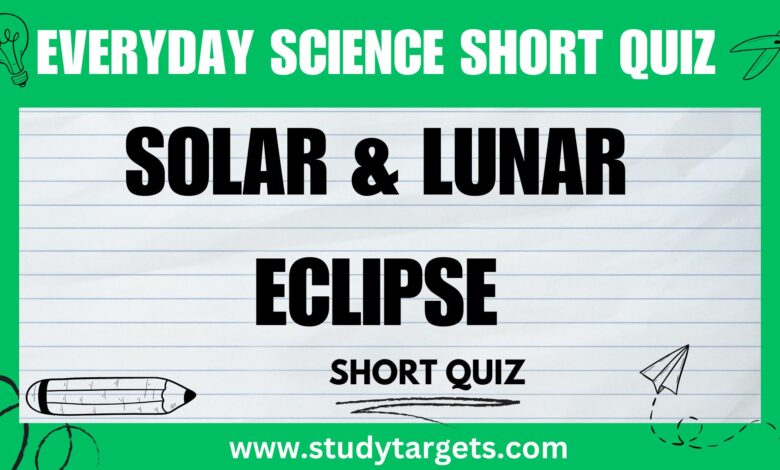Short Quiz : Solar and Lunar Eclipse: Everyday Science

Solar and Lunar Eclipse
1. Question: What is a solar eclipse?
Answer: A solar eclipse occurs when the moon passes between the Earth and the sun, blocking all or part of the sun’s light.
2. Question: What is a lunar eclipse?
Answer: A lunar eclipse occurs when the Earth passes between the sun and the moon, casting a shadow on the moon.
3. Question: What is the term for the shadow cast by the Earth or moon during an eclipse?
Answer: Umbra
4. Question: During which phase of the moon does a solar eclipse occur?
Answer: New Moon
5. Question: During which phase of the moon does a lunar eclipse occur?
Answer: Full Moon
6. Question: What is the term for a partial shadow during an eclipse?
Answer: Penumbra
7. Question: What is the name of the line along which solar and lunar eclipses occur?
Answer: The ecliptic
8. Question: How often do solar eclipses occur?
Answer: Approximately 2 to 5 times a year
9. Question: What is the term for a solar eclipse where the moon covers only part of the sun?
Answer: Partial solar eclipse
10. Question: What is an annular eclipse?
Answer: An annular eclipse occurs when the moon is too far from Earth to completely cover the sun, leaving a ring of sunlight visible.
11. Question: What is the longest possible duration of a total solar eclipse?
Answer: About 7.5 minutes
12. Question: Can lunar eclipses be seen from anywhere on the night side of the Earth?
Answer: Yes
13. Question: What is a total lunar eclipse?
Answer: A total lunar eclipse occurs when the moon passes completely into the Earth’s umbra.
14. Question: What is the term for the point in the moon’s orbit closest to Earth?
Answer: Perigee
15. Question: What is the term for the point in the moon’s orbit farthest from Earth?
Answer: Apogee
16. Question: What is a penumbral lunar eclipse?
Answer: A penumbral lunar eclipse occurs when only the outer shadow of the Earth (penumbra) falls on the moon.
17. Question: What phenomenon causes the red color of the moon during a total lunar eclipse?
Answer: Rayleigh scattering
18. Question: How many types of solar eclipses are there?
Answer: Three (total, partial, and annular)
19. Question: How many types of lunar eclipses are there?
Answer: Three (total, partial, and penumbral)
20. Question: What ancient civilization is known for predicting solar eclipses accurately?
Answer: The Babylonians




